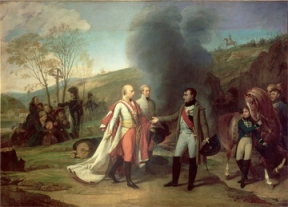
by Daniel Nardini
In 1808, Napoleon Bonaparte invaded Spain. Supposedly an ally of France, Napoleon did not trust the Spanish Crown nor did he trust the people that Spanish King Charles IV (and his successor King Ferdinand VII) surrounded himself with. Napoleon thought that Spain would be an easy conquest, and in the beginning that seemed to be the case. However, the Spanish regular army, loyal to the Spanish king, decided to resist the French occupation. The Spanish army dissolved into partisan fighters. Worse for French, ordinary Spaniards formed partisan groups called guerrillas (derived from the Spanish word guerra for “war”) who attacked and harassed French armies no matter where they were. In the end, the French had to stay in major towns and cities in heavily fortified encampments to control Spain.
But the conflict was two-fold in Spain. There were those guerrillas who were for the Spanish Crown, the Church and the elite classes who had been part of the Spanish monarchy. Then there were other guerrillas who believed in fighting for the masses, the downtrodden of society, and for a more republican form of government. Needless to say, these guerrillas fought other guerrillas as well as the French. This ideological fight was also taking place in Spanish America. Even though the Spanish colonial forces tried to keep its traditional control of all of Spain’s colonies, this control was now being challenged. A growing number of South American revolutionaries were planning the downfall of Spanish rule. The first to raise the revolt was a man named Francisco de Miranda. Miranda managed to take the Venezuelan port city of La Guaira, but then he was betrayed by the ruling council of that city and handed over to the Spanish. Miranda would die in a Spanish prison in 1812.
Other South American revolutionaries stepped into his shoes. Among them were the famous Simon Bolivar, Jose de San Martin, and Bernardo O’Higgins. Simon Bolivar was the famous Venezuelan revolutionary independence fighter who raised the standard of revolt against the Spanish colonial forces in western Spanish America in 1810; Jose de San Martin was the Argentine independence fighter who raised the standard of revolt against Spain in the south in 1812, and Bernardo O’Higgins was the Chilean independence fighter who raised the standard of revolt against the Spanish colonial forces in the east of South America in 1817. All three men believed in an independent republican form of government, and their revolts convulsed the whole of South America in war and revolution.
That left only Spain’s colonies in North and Central America undisturbed for the time being. But even in this case there were fractures in Spanish society in North America. The Spanish criollos, those of pure Spanish blood born and raised in the colonies, deeply resented those Spanish born and raised in Spain, called the Peninsulares, who ruled at the top of Spanish colonial society. Then there were the mestizos, the slaves, and the native indigenous peoples who were just as eager in casting off Spanish colonial rule in favor of home rule. Spain’s main colony in North America (present day Mexico) would soon be set ablaze as well when a lone criollo priest named Miguel Hidalgo y Costilla would issue his “Grito” from the small town of Dolores that started a major revolt among the mestizos and native indigenous peoples in 1810.









